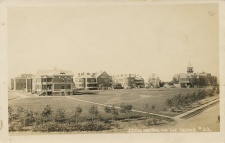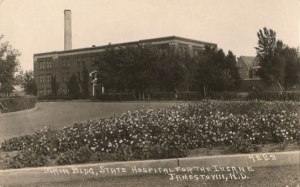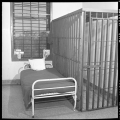Jamestown State Hospital
| Jamestown State Hospital | |
|---|---|
 | |
| Established | 1883 |
| Opened | 1885 |
| Current Status | Active |
| Building Style | Cottage Plan |
| Location | Jamestown, ND |
| Peak Patient Population | 2193 in 1953 |
| Alternate Names |
|
History
The North Dakota State Hospital at Jamestown is one of two state institutions that predate statehood. Its location and mission as a "hospital for the insane" was authorized by the Dakota Territorial Legislature in 1883 and it opened on May 1, 1885, accepting its first two patients from Morton County. Fifty-eight patients whose addresses were in what eventually became North Dakota were moved to Jamestown from the Dakota Hospital in Yankton (now South Dakota). The first superintendent was Dr. O. Wellington Archibald, who had been an assistant surgeon at Fort Abraham Lincoln south of Mandan. By the end of 1886, the average daily census was 106 patients.
But by 1892, conditions at the hospital were so crowded that attics were used for sleeping rooms and even then, patients had to sleep two to a bed, VanBeek wrote. Archibald warned the Legislature that if it didn't appropriate more money for adequate care, the hospital would be closed and each county would have to care for its own insane. He left the hospital in 1894.
By 1904, the census had risen to an average of 401 and still there were no additional buildings. Two buildings had been started in 1903 but construction was halted when the funding process was found unconstitutional, wrote VanBeek. When the state began enforcing laws that allowed it to collect fees from patients' families or their home counties, the construction started again and the two new buildings were completed. Staff was increased so that patients would not have to be locked in their rooms at night or restrained during the day.
The census continued to rise, leaping from 538 in 1908 to 819 in 1912 and then to 1,288 by 1920, wrote VanBeek. In 1914, the hospital was almost closed down because of a smallpox epidemic. Also in 1914, the hospital began to routinely sterilize its "inmates," due to the common belief that their "deficient and degenerate mentality" would be handed down to any progeny. Sterilization was carried out on female patients for many years.
Policies were adopted in the 1920s that were designed to relieve overcrowding by improving patient care. It was hoped the changes would lead to shorter stays and more discharges. The policies included plans for after-care and preparing patients' families for release. Still the census went up, reaching 1,486 in 1929.
During the 1940s, the hospital census continued to rise, reaching 2,027. It was so crowded that VanBeek writes that the institution went through a Dark Ages period, with treatment stifled by the conditions, lack of qualified staff and "general hospital-wide disorganization."
The American Psychiatric Association was brought in to inspect the hospital in 1949. Inspectors made many expensive recommendations, which reached the 1951 Legislature. It's not clear what was done in 1951, but in 1953, the next session increased hospital appropriations, The Forum reported
Then came a period of great reform, under Dr. R.O. Saxvik, who was "loaned" to the hospital from the state Health Department for six years, beginning in 1953. When he took the position, the census was 2,136 and he found chaotic administration, employee confusion, overworked staff and unrest, VanBeek writes.
By 1956, Saxvik had positive news in his biennial report. "In three years time one can see and feel the difference," he wrote. "Gone are the cages, strait jackets, leg irons, stern guards, malnutrition, windowless seclusion rooms, unorganized departments, the sixty-hour work week, the naked despondent patient on a back ward, the odors from wards crammed with untidy and helpless men and women, the tuberculosis patients in disorganized treatment areas, the neglected surgical problems and the bedlam of disturbed units," he wrote in one breathless sentence.
In the 1950s, the hospital began widespread use of tranquilizers on patients to relieve their anxiety and stress. Under Saxvik, the census dipped to 1,886. The 1957 Legislature appropriated money to raze two old buildings. As reforms continued, the hospital received a full three-year accreditation from the Joint Commission on Accreditation of Hospitals in 1961. An adolescent unit was founded in 1963.
One of the best known superintendents, Dr Hubert Carbone, stayed for 16 years, resigning in 1979. By that time, the state had begun moving toward a treatment model that continues today, in which long-term placement in the hospital is discouraged in favor of outpatient treatment in the patients' home areas through the services of the regional human service centers, the use of advanced psychotropic drugs and the regional intervention services. In 1974, the census was 557 patients and the average stay was 60 to 90 days.
The VanBeek history, updated through 1998 by Nancy Schulz, does not give much history of the development of the physical plant, but the campus continued to grow, with many buildings added or replaced, as recently as the 1980s, when the secure forensic unit and Lahaug buildings were dedicated. Meanwhile, the population continued to dip - down to 270 in 1989 - and wards in many of the older building were closed.
By 1997, with many of the hospital's buildings empty or nearly empty and the State Penitentiary in Bismarck fairly bursting at the seams with excess inmates, the Legislature appropriated money to turn three State Hospital buildings into the James River Correctional Center, a medium-security prison on the grounds of the hospital. The two institutions are co-existing on the hill south of Jamestown today. Plans in 2020 call for a request for proposals for the new State Hospital construction project spring of 2021 with construction beginning in the spring of 2022, Etherington said.
Images of Jamestown State Hospital
Main Image Gallery: Jamestown State Hospital



